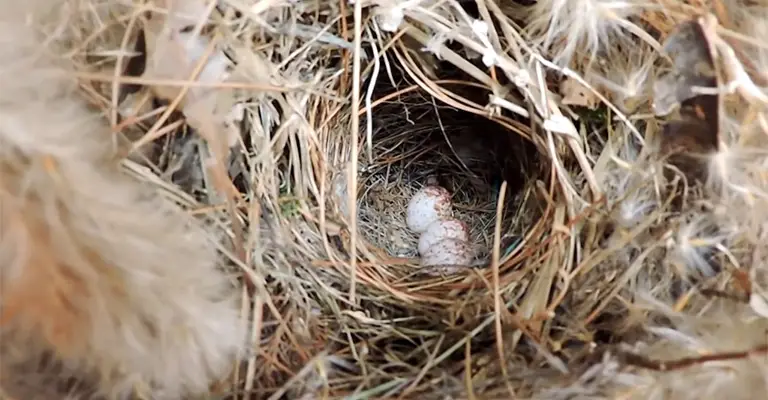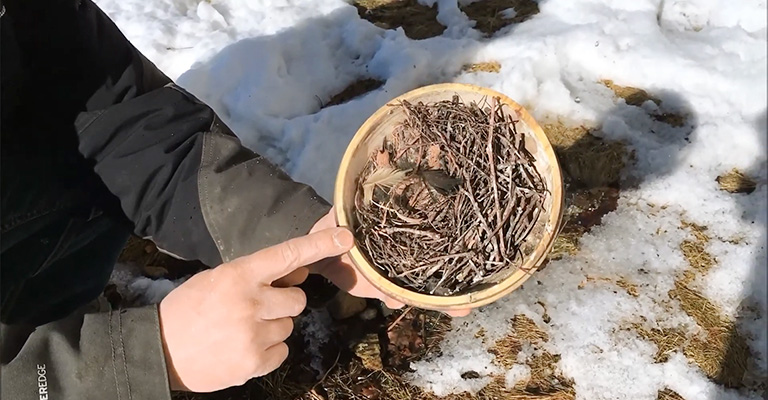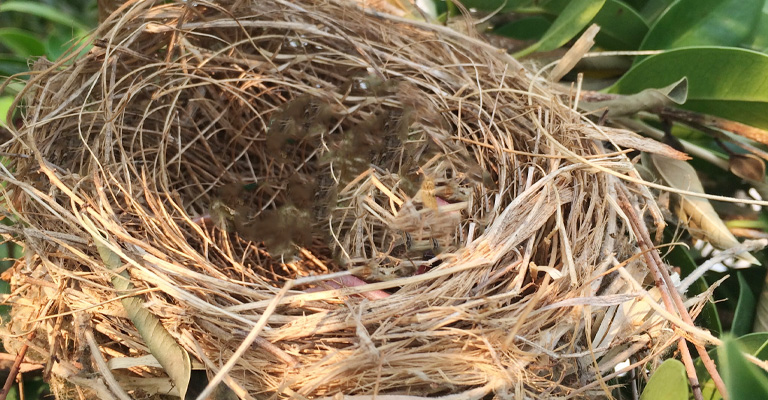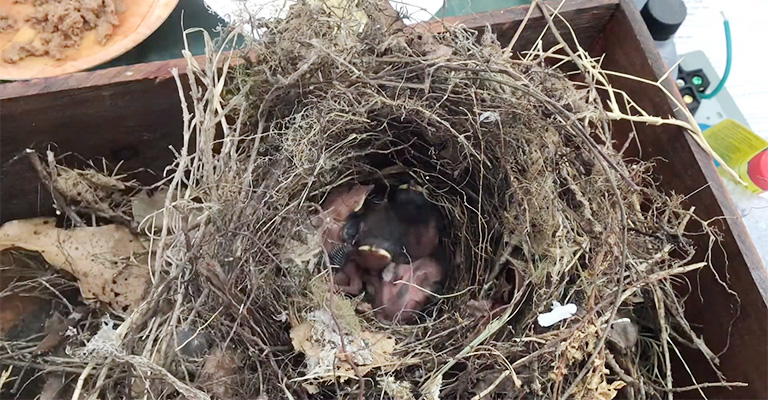The arrival of spring brings with it a flurry of activity in the natural world, as birds diligently prepare for the nesting season. Among the many avian architects, the Carolina Wren stands out with its impressive nest-building skills.
These tiny, vibrant birds construct intricately woven nests that provide a safe haven for their offspring. As we observe these remarkable creations, a question arises: Should we reuse Carolina Wren nests?
In this blog, we delve into the fascinating world of Carolina Wren’s nesting behavior, exploring the benefits and considerations of reusing their nests.
It is indeed essential to understand the ecological implications and the impact on the wrens themselves so that we can make informed decisions about promoting their welfare while appreciating the marvel of their nest-building prowess.
So, let’s dive into the captivating world of Carolina Wren nesting and unravel the mysteries behind the question of nest reuse.

Carolina Wren Nesting Behavior
Carolina Wrens, small songbirds found in North America, exhibit interesting nesting behaviors that showcase their adaptability and resourcefulness.
We will explore the nesting behavior of Carolina Wrens, focusing on their choice of nesting sites, their versatility in nesting near human homes, their use of various materials, and the occasional occurrence of building the first nest on the vegetation-shaded ground.
Typical Nesting Sites: Open Cavities, Trees, Overhangs, Etc.
Carolina Wrens are known to select nesting sites that provide protection and security for their eggs and nestlings. They commonly choose open cavities, such as those found in trees, stumps, or overhangs, to build their nests.
These cavities provide a safe and concealed space, shielding the nest from predators and adverse weather conditions. By utilizing these natural structures, Carolina Wrens create a secure environment for raising their young.
Versatile Nesting Behavior Near Human Homes

One fascinating aspect of Carolina Wren’s nesting behavior is its versatility in adapting to human environments. Near residential areas, Carolina Wrens often take advantage of the structures and resources provided by human habitation.
They have been observed nesting in discarded flowerpots, mailboxes, propane-tank covers, and other items commonly found in urban or suburban settings.
This adaptability allows Carolina Wrens to thrive in diverse habitats, including those influenced by human activities.
Use of Various Materials, Including Discarded Items
Carolina Wrens are resourceful nest builders, incorporating a variety of materials into their nests. They collect twigs, leaves, moss, and grass to construct a sturdy foundation.
Additionally, they may incorporate feathers, animal hair, and plant fibers to create a soft lining for their nest. What makes Carolina Wrens particularly intriguing is their inclination to use discarded items, such as bits of plastic or fabric, in their nest construction.
This adaptive behavior demonstrates their ability to find and repurpose materials in their surroundings.
The First Nest Sometimes Being Built on Vegetation-shaded Ground

Interestingly, Carolina Wrens occasionally build their first nest on vegetation-shaded ground. This behavior deviates from the typical choice of elevated cavities.
The reasons behind this behavior are not fully understood but may be related to factors such as camouflage, protection from predators, or an adaptive response to specific environmental conditions.
While the majority of Carolina Wren nests are built in elevated locations, the occurrence of ground-level nesting highlights their flexibility in selecting nesting sites.
Carolina Wrens exhibit fascinating nesting behavior characterized by their preference for open cavities, their adaptability near human dwellings, their resourceful use of materials, and the occasional choice of vegetation-shaded ground for their first nest.
Case Study: Mamamoosicorn’s Observation
Here are some case studies that will help you understand the fact well.
Mamamoosicorn’s Experience With Carolina Wrens Building a Nest in a Bike Trailer

MamaMoosicorn, a new birder residing in southeastern VA, shared her firsthand experience of Carolina Wrens building a nest in her backyard bike trailer.
This observation provided an opportunity to delve into the nesting behavior of Carolina Wrens and the subsequent events that unfolded.
Absence of Eggs After Two Weeks Raised Concerns and Questions
After the Carolina Wrens completed the nest construction, MamaMoosicorn noticed that the female had not laid any eggs in the nest for approximately two weeks.
This raised concerns and sparked questions about the reasons behind the absence of eggs. MamaMoosicorn’s curiosity stemmed from her desire to understand the intricacies of bird behavior and to ensure the successful reproduction of these avian visitors.
Possibility of Multiple Nests and the Concept of “Decoy Nests”
To shed light on the situation, fellow bird enthusiasts engaged in the discussion, offering insights and potential explanations. One suggestion put forward was the possibility of Carolina Wrens building multiple nests before deciding which one to use.
These additional nests were referred to as “decoy nests,” although the precise purpose of these nests remains somewhat enigmatic. This discussion highlighted the ongoing discoveries and mysteries surrounding avian nesting behavior.
Mamamoosicorn’s Exciting Discovery of an Egg in the Nest
In an update, MamaMoosicorn shared her excitement as she discovered an egg in the nest while tending to her garden. This thrilling development indicated that the female Carolina Wren had indeed begun the egg-laying process.
It brought renewed hope for the successful completion of a clutch and the subsequent hatching of nestlings.
About the Mother’s Absence and the Timing of Egg-laying
Despite the egg’s presence, Mama Moosicorn noted that she had not observed the mother bird actively sitting on the egg. This prompted discussions among the participants regarding the timing of incubation and the potential reasons for the mother’s absence from the nest.
Factors such as the weather, food availability, and the inclination of certain bird species to begin incubating once the full clutch is laid were considered potential explanations for the observed behavior.
Unusual Nesting Behavior
There are some unusual facts about Caarolina’s nesting behavior that might surprise you. here are the facts for your concern.
Other Observations Shared in the Discussion Thread
In addition to MamaMoosicorn’s observations, the discussion thread highlighted some other intriguing behaviors exhibited by Carolina Wrens during the nesting period.
One participant mentioned the birds’ attempts to enter a garage when the door was open. This behavior, although not directly related to nesting, adds to the overall understanding of Carolina Wrens’ inquisitive and exploratory nature.
Acknowledgment That Individual Behaviors May Not Represent Overall Nesting Behavior
It’s important to note that individual observations shared in the discussion thread may not fully represent the overall nesting behavior of Carolina Wrens.
Each bird and nesting pair can display unique behaviors influenced by various factors, including environmental conditions, individual traits, and specific circumstances.
Therefore, while the shared observations contribute to our knowledge and appreciation of Carolina Wrens, they should be considered anecdotal evidence rather than conclusive findings.
Factors Influencing Nest Reuse
Nest reuse is a complex behavior influenced by various factors specific to each bird species. When it comes to Carolina Wrens, several factors play a role in determining whether they will reuse a nest or build a new one each breeding season.
Relevance of Nest Condition and Location
The condition and location of a nest are crucial considerations for Carolina Wrens. A nest that has remained structurally sound and offers adequate protection may be suitable for reuse.
Carolina Wrens inspect the nest’s integrity before deciding whether to reuse it. Factors such as weathering, damage, or contamination can affect their choice.
Additionally, the nest’s location may also be important, as Carolina Wrens prefer safe and concealed sites that provide optimal protection for their young.
Carolina Wrens’ Tendency to Build New Nests Each Year
Carolina Wrens have a natural inclination to build new nests each breeding season. This behavior is thought to be driven by several factors, including maintaining hygiene, reducing the risk of parasites or pathogens, and ensuring the nest’s structural integrity.
Building a new nest allows them to start fresh and potentially improve upon previous nest designs. This tendency reflects their adaptability and commitment to providing the best possible nesting environment for their offspring.
Possibility of Carolina Wrens Reusing Nests in Subsequent Breeding Seasons
While Carolina Wrens generally build new nests each year, there are instances where they may reuse a nest from a previous breeding season. This reuse typically occurs when the nest meets specific criteria, such as being in good condition and located in a favorable spot.
Reusing a nest can save time and energy, as it eliminates the need for extensive nest-building efforts. However, it’s important to note that nest reuse is less common for Carolina Wrens compared to some other bird species.
Ultimately, the decision to reuse a nest or build a new one is influenced by a combination of factors, including nest condition, location, and the species’ natural tendencies.
FAQs
Carolina Wrens generally have a tendency to build new nests each breeding season. While they may occasionally reuse a nest if it meets specific criteria, nest reuse is less common compared to some other bird species.
Carolina Wrens prefer nest locations that provide safety and protection for their young. They often select open cavities, trees, overhangs, or other sheltered spots.
Nest placement may vary depending on factors such as vegetation cover, proximity to food sources, and accessibility.
Yes, Carolina Wrens are versatile nesters and can make use of human-made structures near homes. They may utilize discarded flowerpots, mailboxes, propane tank covers, or other items as nesting sites.
Carolina Wrens typically lay between 3 to 7 eggs in a clutch, with 4 to 5 eggs being the most common. The female incubates the eggs for about 12 to 16 days until they hatch.
If a Carolina Wren’s nest is disturbed or destroyed, the pair will typically rebuild the nest or find an alternative nesting site nearby. They are resilient and adaptable when it comes to responding to nest disturbances.
Conclusion
Carolina Wrens display fascinating nesting behavior, utilizing various sites and materials near human homes.
While they typically build new nests each year, they may occasionally reuse a nest if it meets specific criteria. Factors such as nest condition, location, and natural tendencies influence their nesting decisions.
Through our exploration, we have gained insights into the remarkable nesting behavior of these birds and the potential benefits and considerations associated with nest reuse.
While reusing Carolina Wren nests may seem like a convenient option, it is important to weigh the ecological implications and the welfare of the wrens themselves.
Hopefully, you understand the fact well. Please inform us if anything is still unclear to you. Thank you for your time.